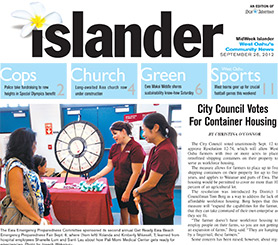City Council Votes For Container Housing
The City Council voted unanimously Sept. 12 to approve Resolution 12-74, which will allow West Oahu farmers with two or more acres to place retrofitted shipping containers on their property to serve as workforce housing.
The measure allows for farmers to place up to five shipping containers on their property for up to five years, and applies to Waianae and parts of Ewa. The housing would be permitted to cover no more than 10 percent of an agricultural lot.
The resolution was introduced by District 1 Councilman Tom Berg as a way to address the lack of affordable workforce housing. Berg hopes that this measure will “expand the capabilities for the farmer, that they can take command of their own enterprise as they see fit.
“The farmer doesn’t have workforce housing to employ people on their farms, so you are not getting an expansion of farms,” Berg said. “They are hanging by a fingernail, these farmers.”
Some concern has been raised, however, about regulation and enforcement surrounding the resolution. West Oahu County Farm Bureau president Jeanne Vana said she and other area farmers are wary about the resolution.
“Is this a situation for housing the homeless, or is this for bona fide farm workers?” Vana asked. “I think it would be great for bonafide farm workers, but I have some real concerns if it goes the other way.
“Is it creating work opportunities for those who do not have current housing and sliding them into a new area of profession?” Vana said.
The measure, Berg said, is designed to be a relationship between the land-lord and the tenant ― and whomever each farmer chooses to hire is up to each farmer.
“Basically, if someone is to reside inside of such a dwelling unit, they are to be employed on the farm,” Berg explained. “The landowner … will get to determine who they want to hire.” Berg acknowledged that hires could include homeless individuals, if the farmer chooses.
Vana acknowledged that there is a need for agricultural workforce housing, and said that this could be a good option for some farmers and people looking for work, but asserted that the measure needs stronger enforcement regulations ― including workforce performance measurements, tenant vehicle registrations, drug testing for tenants and property sanitation monitoring.
“What we don’t want to have is have it become a liability issue for the farmer,” Vana added. “We have to protect the farmers first. There have got to be some security measures put in place. There has got to be some kind of a system in place to screen applicants.”
Vana also asserted that because many farmers lease land, it could be up to the landlord ― rather than the individual farmer ― to determine whether temporary housing is permitted
“I see that it could be a real benefit to select farmers who own their own land, and other cases where it could be more of a burden.”
Under workforce housing regulations, a farmer who wishes to place a unit on his or her property must alert their area neighbor- hood board ― one thing that Berg said will provide or oversight of the properties. Each container also would be required to meet health and safety codes as outlined by the city Department of Planning and Permitting and the state Department of Health.
Berg said that another benefit of allowing this type of housing is that it could help farmers guard their property against theft, vandalism and illegal dumping.
“It is not only going to provide workforce housing for the farmer, but because of (the container’s) mobility, you can situate this on the land where you need to,” Berg said. “Now you will have eyes and ears on your property. You’re going to be able to have the security that you need.”
Berg explained that old shipping containers can be retrofitted to include all the amenities of a small apartment ― including a bedroom, a kitchen, a bath- room, flooring and windows.
“This is to let the farmers take command of their needs,” Berg said. “For (farmers) to find help … and having someone be able to live on their property, they can work out a relationship that is beneficial.
“It’s a symbiotic relationship is what it is.”
The resolution is a revised version of Berg’s 2011 proposal to transform recycled shipping containers into low-cost temporary housing.






